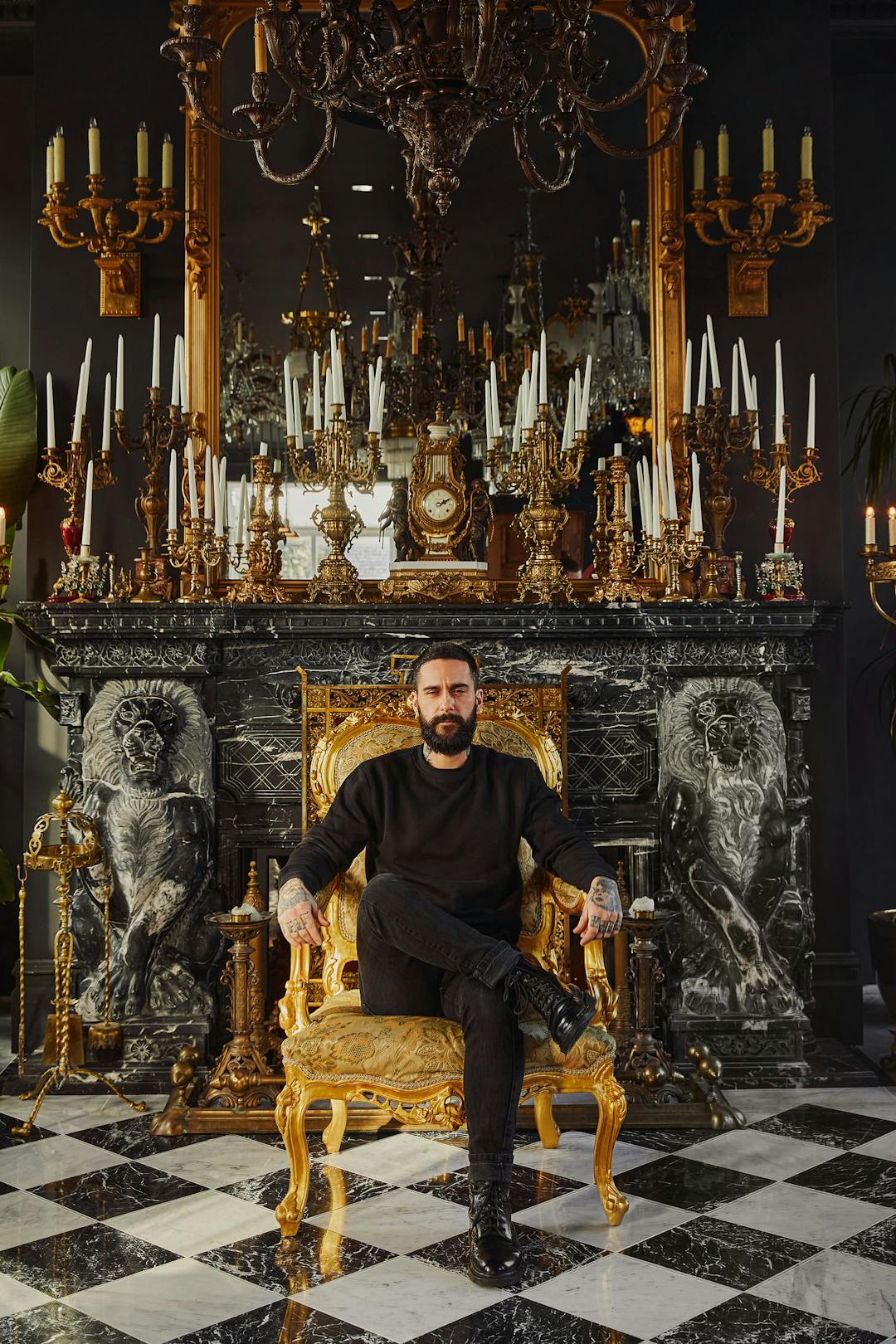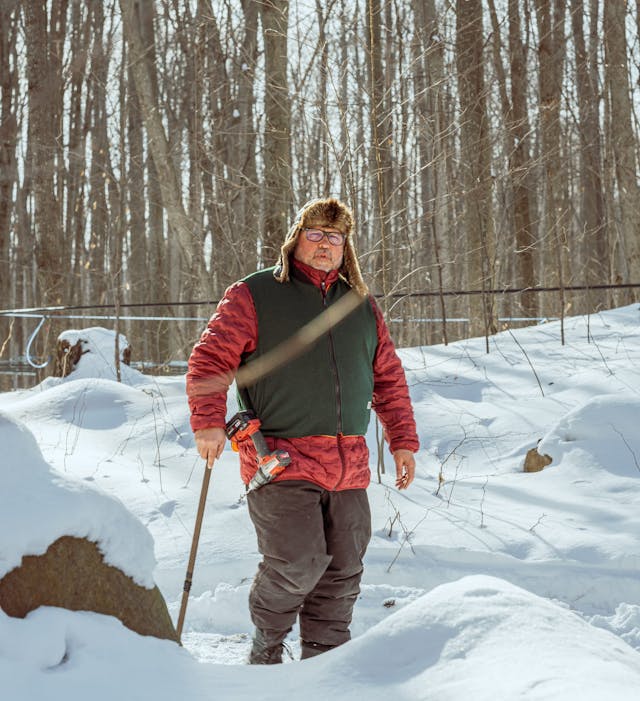Manoir Blackswan's Emmanuel Hébert: The international antique and art hustler straight outta Montreal
An antique dealer, builder, artist, designer, entrepreneur, high school dropout and a self-described lover of life—and the 6,500-square-foot hybrid residence-showroom he calls home.
 The international antique dealer, builder, artist, designer, entrepreneur, high school dropout, self-described lover of life, and owner and founder Emmanuel Hébert of Manoir Blackswan. | Photograph: Courtesy Manoir Blackswan
The international antique dealer, builder, artist, designer, entrepreneur, high school dropout, self-described lover of life, and owner and founder Emmanuel Hébert of Manoir Blackswan. | Photograph: Courtesy Manoir BlackswanOwner and founder Emmanuel Hébert of Manoir Blackswan knows how to hustle.
The international antique dealer, builder, artist, designer, entrepreneur, high school dropout and a self-described lover of life has never known a moment in life where he hasn’t been on the move and selling something.
Working in what could be considered one of the most, if not the most, extreme antique galleries in or around the city, Hébert made more than a name for himself in the dying market of antique dealing.
A practice normally relegated to the odd shops found in the dusty corners of Montreal, Hébert’s built a place that’s testament to his passion for living, breathing, eating, sleeping, and deal in antiques: A 6,500-square-foot hybrid residence-showroom he not only sells from but lives in.

The Colonial-style mansion where his childhood home once stood, 30 minutes off the south shore from downtown Montreal, began construction in 2020 and was finished in 2022 thanks to working alongside a litany of craftspeople and specialists in everything from coppersmiths to plasterers and cabinet-makers.
“I want this to outlast both me and my son,” he says.

To be it is to live it
For now, it is a place where nearly every article, save for a few personal items—chandelier, art, clawfoot bathtub, mirror, taxidermy animal, table, you name it—across the six-bedroom, three-bathroom home is for sale in addition to three other warehouses full of collections.
The living room features a massive fireplace mantle from two blocks of white-veined black marble from Spain's Basque Country; the front door is flanked by two fixtures recovered from the Fairmont Royal York in Toronto; stuffed peacocks; every room has been curated with care and balance, absolute maximalism, or a combination thereof.
His collection of items has grown to include whole buildings, having gone so far as to purchase architectural pieces, inside and out, from a nearby desacralized church in Salaberry-de-Valleyfield that ranges from lanterns and columns to marble tiles and exterior lighting. Then there’s a heritage stone estate Héritage du Mille in Sainte-Clotilde from 1838, which he rents out for photo and film shoots.
“All these places connect me with new people and share our passions and projects… I became a designer over time because I’ve worked on so many projects. I’ve always been intrigued by architecture and design,” Hébert says.
“But Manoir Blackswan? This is my first big experiment.”


Photograph: Courtesy Manoir Blackswan
Named after the theory of black swan events—high-impact occurrences that are difficult to predict under normal circumstances but, in retrospect, appear to have been inevitable—each facet and detail inside and out speaks to a deep, burning passion for his business.
“I probably have the widest perspective on antiques of my life at this point: I see them in a multi-purpose way. I see them as visuals, for design projects in restaurants or home, for movies as set pieces, and props content creation,” he says.
“When you look at antiques the way I do, it makes sense to collect them, purchase them, embrace them, and sell them, because I want people to love them as much as I do.”


A 17-foot sacristy cabinet Hébert salvaged from a church. | Photograph: Courtesy Manoir Blackswan
To hustle is to know the story
Hébert will sometimes be on the road for upwards of 30 hours at a time, arriving to piles of belongings, digging through to find one piece, and working as much as an additional 20 hours to restore it to its former glory.
“I’m not your classic antique dealer. I don’t have parents in the industry, and in a way, I debunked it. Most dealers I know that are my age—and there aren’t many—are going into thrift shops and trying to flip what they find on eBay.”
“Not to discredit what they’re doing, but I don’t think this is what it means to sell antiques. There’s a history to everything, and when you have a story behind a rare piece, it sells for a higher price. You have to hone your eye, know what you’re selling and buying, and stories are central to selling pieces.”


Emmanuel at work. | Photograph: Courtesy Emmanuel Hébert
But what does it take to be an antique dealer according to Hébert?
“First, if you know how to sell, that’s a start. It’ll be easier to share its story, but you need to be convincing. Being kind and welcoming is important as well; even incredible dealers can have a bad reputation without that.”
“Being curious is key, as is willing to learn. I’ve spent so many hours drinking tea with older generations, listening to their stories, spending valuable time with them not only to learn but to share their knowledge. Many have no one—this is the last generation that saw everything in the last 40, 50 years—and so many of them I’m still friends with.”

“And you need to be passionate. You need to think, sleep, and eat antiques, because otherwise you’re going to get bored. It’s not all rainbows and sunshine. There are long hours on the road, and there are plenty of very unsexy moments like that… You need to be obsessed, or it’ll break you.”
“And finally, there’s understanding design and how to place your product. If you have a customer who brings you into their dining room and you’ve 200, 300 chandeliers to exhibit? They’ll need help navigating that.”


Photograph: Courtesy Manoir Blackswan
Born a hustler
It can be strange to visit Manoir Blackswan’s combination of a living space, private gallery and creative studio. For someone who has created and built so much, Hébert moves slowly and deliberately through it, and speaks in the same fashion about his own life.
“I was always hustling,” Hébert says. “I was making mixtapes and selling them at 14. At 16, I bought a Cadillac Fleetwood Brougham that was big enough to put six friends in the trunk, and was reselling clothing out of it.”
Getting his first real start with restoring paint jobs on cars at 18 with his own garage, having purchased his mother’s 1963 bungalow to run an antique business out of its basement—the site where Manoir Blackswan now stands.
Back then, before the manor, he had bought the rustproofing business Krown Rust Control and was taking on everything from municipal to military contracts. But working 100 hours a week?
“I realized I was bored. I was making good money, but I was always repeating the same thing over and over. So I sold everything and decided to start over from scratch.”


Photograph: Courtesy Manoir Blackswan
Finding passion
Hébert turned to India. Hearing how life-changing it would be to backpack there, “I got there, and it fucked me up… The colours, the textures, the craftsmanship? The delicacy of their cuisine? It was just the way they are.”
“The most beautiful moment I had there was meeting someone who said ‘you know what, Emmanuel? You guys have nice watches where you’re from. But do you know what we have? Time.’ To this day, I have chills from that. It made me realize that if you’re not doing something that you’re really passionate about in life, you’re going to lose your life doing something you don’t like, and working more than you’re living.”

So India was where Hébert first fell in love with antiques. Following a period of voracious reading and starting his company Historical Lights in 2017, all he wanted to do when he returned was to collect and sell.

“When I first started in the antique business, I wanted to restore them. There was always this purpose of giving a new life to things that people lost value in.”
“Take lighting fixtures, which changed my perspective; electricity is a (relatively) new technology, and all the styles that emerged from the late 19th century to the early 20th century—the Arts and Crafts movement, Art Nouveau, Art Deco, Bauhaus—became the way to express yourself as an architect or designer.”
“Nowadays, we take it for granted, but back then, it was one of our finer luxuries.”


Photograph: Courtesy Manoir Blackswan
It never ends
Even with everything that’s been accomplished to this day, the next phase of Manoir Blackswan is in sight: Expected to take two years (minus the year it took to plan it with city and regional representatives), Hébert is creating a second event and content creation space connected to the manor that will invite creatives into this universe.
It’ll total 11,000 square feet of added space with a 2,100 square foot Gilded Age ballroom that the antique dealer and designer says will be similar to what’s found in French castles. Working with artisans both local and specialized in movie sets to create things from noble materials, there will also be a commercial kitchen, art gallery, speakeasy, and wine cellar.


Photograph: Courtesy Manoir Blackswan
Beyond this, Hébert wants to revive what he sees is as the dying industry of antique dealing and creating an institute to teach new generations how to buy, collect, and sell antiques. The ‘Hébert Institute of Antiques and Decorative Arts' will feature courses for an online community. “I’m a reflection of all the people and books I’ve learnt from, and now, I want to give back to the community and share all my knowledge,” he says.

Learn more about Manoir Blackswan.
![The Bulletin: Cheers to spring, here's where to grab your next drink 🍸 [Issue #72]](/_next/image?url=https%3A%2F%2Fthemain.ghost.io%2Fcontent%2Fimages%2F2024%2F04%2Fezgif.com-webp-to-jpg-converter.jpg&w=640&q=75)
